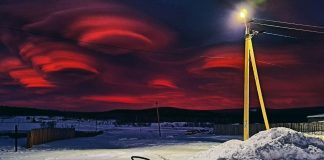
Updated on:
From stackable lenticular “UFO” clouds to pouchy mammatus, glowing nacreous colors and wildfire-born pyrocumulus—this page is your master guide to the world’s strangest unusual clouds. Some are optical (ice-crystal prisms). Others are dynamic sky-sculptures driven by wind, terrain, and fire.
Across history, people have reported rare cloud formations that confuse pilots, inspire myths, and go viral. Meteorologists classify them by physics (wave, convective, stratospheric, mesospheric), while folklore calls them omens. This sub-hub collects the best examples, quick IDs, photography tips, and explainers—so you can name that weird sky thing fast.
Jump to: Lenticular UFO · Mammatus · Asperitas · Nacreous · Noctilucent · Roll vs Shelf · Pyrocumulus · FAQs · Latest Reports
Key facts (TL;DR)
- Unusual clouds = wave, optical, convective, stratospheric, or mesospheric phenomena (not UFOs!).
- Fast IDs: lens & stacks (lenticular); pouches under anvils (mammatus); wavy sky-sea (asperitas); pearly glow (nacreous); night-shining blue (noctilucent); tube detached (roll) vs attached wedge (shelf); smoke-fed towers (pyrocumulus).
- Pro tips: include the Sun/Moon height, wind, terrain & horizon in photos; keep EXIF; shoot RAW if possible.
- Weather signals: mammatus/shelf often mean turbulent storms; halos/pearlescence hint at ice crystals aloft.
📩 Report an unusual cloud (time, location, weather, photos/video)
Explore by Type
- 🛸 Lenticular (UFO) Clouds — mountain wave lenses; stationary, stacked discs.
- ☁️ Mammatus — pouchy underbellies of thunderstorm anvils.
- 🌊 Asperitas — the “stormy sea” sky; recognized in 2017.
- 🌈 Nacreous (Mother-of-Pearl) — iridescent stratospheric glow in polar winters.
- 🔵 Noctilucent (NLCs) — night-shining electric blue, ~80 km high.
- 🌪️ Roll vs Shelf Clouds — detached tube vs attached gust-front wedge.
- 🔥 Pyrocumulus / PyroCb — wildfire/volcano-driven towers & lightning.
Lenticular (UFO) Clouds
Smooth, lens-shaped clouds form over ridges when stable, moist air oscillates—creating stacked saucers that barely move.
- Spot it: stationary, layered discs near mountains; sharp edges at sunset.
- See cases: Lenticular gallery · Mount Shasta stack
Mammatus Clouds
Bulbous pouches hang beneath anvils after severe convection—ominous-looking, but not tornadoes by themselves.
- Spot it: honeycomb of pendulous lobes under storm anvils.
- See cases: Mammatus photos & video
Asperitas Clouds
A churning, wave-like ceiling resembling an upside-down ocean; officially added to the cloud atlas in 2017.
- Spot it: chaotic undulations, mottled light/dark bands.
- See cases: Asperitas around the world
Nacreous (Mother-of-Pearl) Clouds
Iridescent pearlescent sheets in the stratosphere light up at twilight in polar regions—beautiful, rare, and chemistry-sensitive.
- Spot it: shimmering pink/green/blue near twilight, high on the sky.
- See cases: Murmansk pearly skies
Noctilucent (Night-Shining) Clouds
Mesospheric ice at ~80–85 km glows electric blue after sunset; best in summer at high latitudes.
- Spot it: thin, rippled, luminous bands low on the northern horizon 60–90 minutes after sunset.
- See cases: Rare NLC observations
Roll vs Shelf Clouds
Roll clouds are detached rotating tubes. The most amazing roll cloud is the Morning Glory, a massive tubular roll cloud stretching over 1,000 km, most famously in northern Australia. In contrast, shelf clouds are attached arcus along storm gust fronts—often the dramatic “sky tsunami.”
- Spot it: roll = free-standing tube; shelf = wedge attached to storm with gusty winds.
- See cases: Roll cloud primer · Shelf cloud in action
Pyrocumulus / Pyrocumulonimbus
Intense heat from wildfires or eruptions drives towering convection; can evolve into PyroCb with lightning and dangerous outflows.
- Spot it: cauliflower tops over smoke columns; anvil & lightning = PyroCb.
- See cases: Fire clouds & lightning
Unusual Clouds — FAQs
- Are unusual clouds dangerous?
- Most are harmless to observers. However, shelf clouds mark storm gust fronts; pyrocumulus/pyroCb can bring lightning and erratic winds. Treat them like severe weather signals.
- Why do lenticulars get mistaken for UFOs?
- They’re smooth, stationary, and stacked—classic saucer silhouettes—especially when sunset lighting sharpens edges.
- Do mammatus mean a tornado?
- No. Mammatus indicate strong convection and turbulence but are not a tornado signature by themselves.
- Where can I see nacreous or noctilucent clouds?
- Nacreous: polar winters at twilight; Noctilucent: summer evenings at high latitudes (look low north 60–90 minutes after sunset).
- How should I photograph rare clouds?
- Include horizon/scale; shoot wide for structure, tele for detail; bracket exposures for iridescence; keep EXIF (time, focal length, GPS) for documentation.
Sources & Further Reading
- Atmospheric Optics – halos, arcs & iridescence
- UK Met Office – cloud guides & weather
- NOAA – severe weather & convective storms
- NASA – NLCs, sprites & upper-atmosphere research
Latest Reports
See the newest stories in our Unusual Clouds coverage:
Get Involved
- 📩 Report an unusual cloud (time, location, weather, photos/video).
- 📰 Subscribe to our newsletter
- ❤️ Support on PayPal · DonorBox








